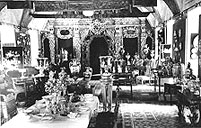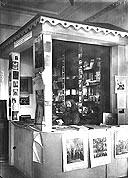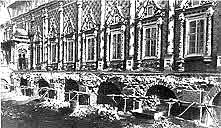The Main Steps of the Museum Activity (page 2)
 The collection of Old Russian art formed the basic part of the museum. For the first time its unique significance and role in the development of Russian spiritual and cultural life were discovered in the articles of the small edition “The Trinity-St. Sergius Lavra” published by the Commission in 1919.. The Treasures of Old Russian art were never hidden. In 1920, the displays and exhibitions presented nearly the whole Monastery collection.
The collection of Old Russian art formed the basic part of the museum. For the first time its unique significance and role in the development of Russian spiritual and cultural life were discovered in the articles of the small edition “The Trinity-St. Sergius Lavra” published by the Commission in 1919.. The Treasures of Old Russian art were never hidden. In 1920, the displays and exhibitions presented nearly the whole Monastery collection.
 Nevertheless, in 1930s the prevailing anti-religious tendency practically lead to their closing. The exhibitions of that time called “ The Lavra and its Connections with Tsarist Autocracy at the Epoch of Feudalism ”, “Everyday Life of the Higher Clergy” were characteristic. At that time a part of the collection of the 18th – 19th century passed to the State Depository and other museums.
Nevertheless, in 1930s the prevailing anti-religious tendency practically lead to their closing. The exhibitions of that time called “ The Lavra and its Connections with Tsarist Autocracy at the Epoch of Feudalism ”, “Everyday Life of the Higher Clergy” were characteristic. At that time a part of the collection of the 18th – 19th century passed to the State Depository and other museums.
 Since the first years of the Museum history there began the restoration of the architectural monuments of the Trinity-St. Sergius Lavra, as their condition had been the scientific world’s concern since the beginning of the 20th century. The best specialists were engaged in that work: P.D. Sukhov began the restoration of the Trinity Cathedral, P.D. Baranovsky made a reconstruction model of the Church of the Holy Ghost based on the research.
Since the first years of the Museum history there began the restoration of the architectural monuments of the Trinity-St. Sergius Lavra, as their condition had been the scientific world’s concern since the beginning of the 20th century. The best specialists were engaged in that work: P.D. Sukhov began the restoration of the Trinity Cathedral, P.D. Baranovsky made a reconstruction model of the Church of the Holy Ghost based on the research.
 In 1938, the General Restoration Plan of I.V. Trofimov, worked out with the participation of A.V. Shchyusev, was adopted. The restoration, according the General plan, was supervised by the Museum Scientific Council, including the outstanding scientists I.E. Grabar, A.V. Artsikhovsky, S.V. Bakhrushin, M.V. Nesterov,etc.
In 1938, the General Restoration Plan of I.V. Trofimov, worked out with the participation of A.V. Shchyusev, was adopted. The restoration, according the General plan, was supervised by the Museum Scientific Council, including the outstanding scientists I.E. Grabar, A.V. Artsikhovsky, S.V. Bakhrushin, M.V. Nesterov,etc.
|


